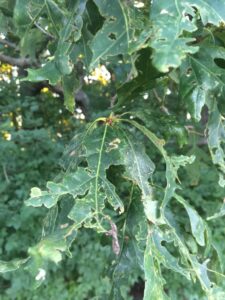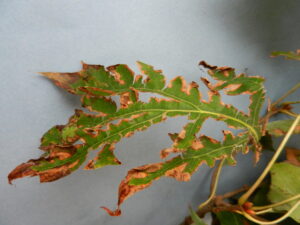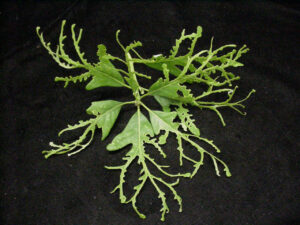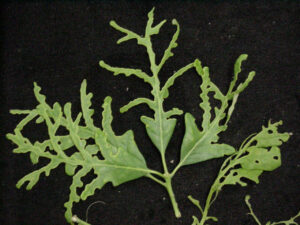Each spring the PPDL receives several samples of oak trees showing curled, twisted, stunted and/or generally ratty looking leaves. When there are holes in the leaves or leaf edges are missing tissue, we add another symptom name to the mix: tatters.
Distorted new growth and tatters are most common on white oaks and may occasionally show up on red oak, hackberry and other trees. Upon initial inspection the leaves look as if they have been shredded or severely fed upon by insects. However, a closer observation of the leaves will reveal that the leaf tissue has not been removed, but rather, it never developed normally. We have seen this problem on white oaks for many years in Indiana and it has been reported in other states throughout the Midwest.
Several possible causes for this symptom have been proposed, including poor growing conditions, insect injury, leaf diseases, late spring frost damage and herbicide drift; however, no single factor serves to explain all the cases. In 2020 we saw a distinct link between tattered oak leaves and a late spring frost that year but the connection is not always so clear cut.
Researchers have shown that acetochlor and s-metolachlor drift can cause tatters-like symptoms but results were variable, and in some treatments red oaks were more affected than white oaks, contrary to the expected results. In many instances there is no direct link to herbicide drift. We once had samples from a white oak tree that showed symptoms of tatters and leaf curl every year, yet was located in the middle of a heavily forested area miles away from any agricultural fields that might have been a source of herbicide drift. While the exact cause may not be clear, it does appear that conditions that lead to tatters occur while the leaves are still developing.
If the problem has only appeared on the affected tree once in a while, then it is more likely to be linked to late spring freeze damage as leaves were expanding. If it shows up on new leaves throughout the summer, or on the same tree(s) year after year, then the cause is more likely linked to growing conditions and the site. You can check for damage to trunk and roots and trunk decay to rule out those conditions as possible contributors. If the soil has not been tested recently it may be helpful to send soil samples from the root zone of the tree to check for nutrient deficiencies. Trying to improve the overall health of the tree with proper nutrition, mulch and irrigation to reduce stress factors may help prevent a recurrence.
Additional information on tatters: Iowa State – https://hortnews.extension.iastate.edu/oak-and-hackberry-tatters
White Oak and Northern Red Oak Leaf Injury from Exposure to Chloroacetanilide Herbicides – https://doi.org/10.21273/HORTSCI.45.4.696



